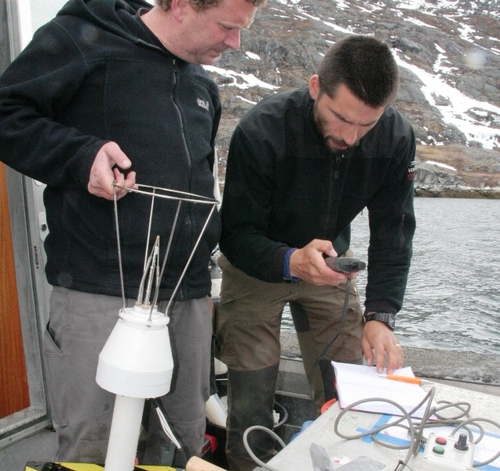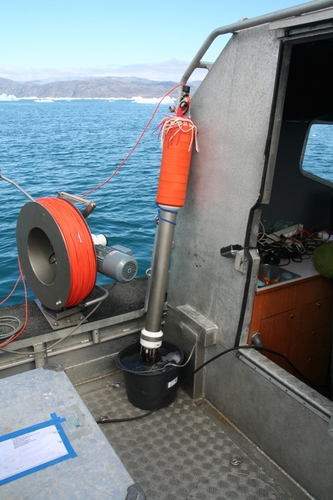Test of new climate research equipment Published 10.07.2011

A PhD project in collaboration between the Greenland Climate Research Centre in Nuuk and the University of Southern Denmark has in recent weeks tested advanced research equipment Utoqqarmiut Kangerluarsunnguat (Buksefjorden).
The overall goal is to be able to estimate the amount of fresh water melting from the Ice Sheet and flowing out to Kangersuneq and beyond to Kangerlua Nuuk (Godthaabsfjord). Knowledge of the amount of freshwater flowing from the Ice Sheet is an important part of climate research as it affects the fjord’s water masses and thus the ecosystem and the living creatures in the fjord.
Before this can happen, it has been decided to test and optimize the methodology and measuring instruments under better known conditions. Utoqqarmiut Kangerluarsunnguat (Buksefjorden) was chosen for that. The reason is that here is a hydroelectric plant, which has very precise figures for the amount of freshwater flowing into Buksefjorden. In this way data from the climate centre’s measuring instruments can be compared directly with the power station’s measurements, so it can verified whether the measuring equipment and measuring method works properly.
The complicated measurements are performed using different equipment. First, several proven and reliable oceanographic instruments are used, including ADCP (Acoustic Doppler Current Profiler), which measures sea water velocity and CTD (Conductivity, Temperature, Depth), which measures the salinity / temperature / depth. A couple of newer instruments, called microstructure profilers, are also used. They measure the vertical movement / turbulence in the water while they are moved up or down in the water column. Measurement data from the different instruments are used to calculate the energy in the water, which is later used to estimate the amount of fresh water flowing out from hydroelectric or ice sheet.
Kunuk Lennert, project manager and PhD student, says that the field work has gone smoothly and ahead is now a few weeks of extensive work to analyze the vast amounts of measurement data. If everything goes well measurements in Godthåbsfjord could take place in the summer of 2012.

The MSS profiler is a larger version of SCAMP, which instead measures while it sinks. Data is read directly the measurement from a computer during via cable. After reaching the bottom it is pulled back to the surface by winch. It can be used down to 600 meters depth. Photo: Sabine Flury

